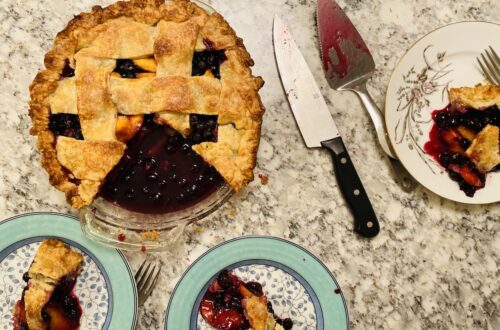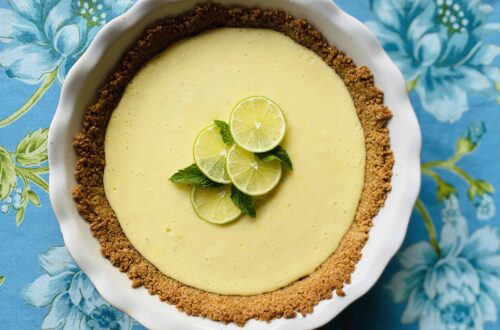
Flourless Chocolate Cake
This cake is perfection. It’s dense, but not too intense, enticing you to eat just another small bite again and again … and again … until you’ve actually eaten quite a large slice (or, perhaps, the whole cake). Everyone loves this cake. It’s the perfection of gluten-free: you don’t notice that there’s no flour in it, just that it’s like eating rich chocolate clouds.
However, when I went back and looked at the ingredients, I realized how unethical a cake it is. Cocoa. Sugar. Butter. Almonds. Eggs. Other than water and salt, almost all the ingredients in this cake have a variety of problems in their supply chains. (The cocoa supply chain relies on forced labor, child labor, and causes deforestation, among other issues; sugar production relies on forced labor and often harms the environment; butter produces greenhouse gases and often has labor abuses – you get the idea.)
One ingredient in the cake that has a more complicated supply chain is vanilla. These days, vanilla is a mainstream baking ingredient, yet most of us have no idea what it is or where it actually comes from – just that it’s rare and annoyingly expensive.
So, where does vanilla come from? Today, about 80 percent of all vanilla beans come from Madagascar, with smaller amounts grown in Indonesia, Uganda, Mexico, French Polynesia, China, and Papua New Guinea. In the US, we generally know and use vanilla as vanilla extract, a key ingredient in baking. Vanilla extract is made by soaking vanilla pods in alcohol to get as much flavor as possible out of them.
But what is vanilla? Vanilla is a member of the orchid family, which encompasses 25,000 different species – yet it is the only edible member of the family. Vanilla is an amazing plant. It reaches “lengths of up to 300 feet, from which sprout pale greenish-yellow flowers, about four inches in diameter.” But the really astonishing thing about vanilla is that these plants have to be pollinated by hand. Only in Mexico, where vanilla originates, are the plants pollinated by nature – specifically, by melipona bees and local hummingbirds, both found only in Mexico. Moreover, the window for pollination is incredibly short. Each flower is open for a mere 24 hours, at most. If not pollinated in that short window, the flower wilts and dies instead of becoming a vanilla pod. Despite these challenges, each year vanilla farmers fertilize about 40 million vanilla plants – by hand.
As with coffee and cocoa, the flavor we know as vanilla only comes through once the fruit has been dried and cured. Curing varies by region, but there are generally four steps: killing, sweating, drying, and conditioning. After the still-green pods are harvested, they are blanched in hot water, which stops fermentation. The vanilla pods are then put in a large container for 36-48 hours to “sweat.” At this point, the pods begin to change from green to brown, and the vanilla aroma develops. The pods are then dried during the day and sweated (covered) at night for anywhere from five to fifteen days.
For years, growing vanilla was not especially profitable for vanilla farmers. But about a decade ago the price of vanilla shot up, from $50 per kilogram in 2013 to $600 per kilogram in 2017. (Madagascar kept prices stable around $50-60 before the mid-1990s, when the World Bank went on its neoliberal spree of forcing Global South countries to accept its free market policies and Madagascar loosened price controls.) The high price has brought a new level of prosperity to vanilla-growing regions, and vanilla farmers now earn far above a living income. They can buy televisions and satellite dishes, access electricity, build new houses, buy cars, and send their children to school. But these rural villages, where smallholder farmers grow vanilla, often don’t have banks, leading farmers to hold onto large caches of money hidden at home — which can lead to theft.
This boom has also led to theft of vanilla, often before it has fully ripened. Because of the high price paid for vanilla beans, thieves can make money by selling stolen pods, even when they haven’t reached peak ripeness. At the same time, such widespread theft incentivizes farmers to pick their own pods too soon to avoid having them stolen. (One alternative is camping out in the jungle with guns, clubs, and spears to scare off potential thieves. Another is marking the beans with a symbol so that they are harder to sell if stolen – the latter seems like a better option.) As a result, when the price of vanilla is high, theft is high and farmers harvest their pods early, before the fragrant vanillin (which emerges right before the pod ripens) has developed. This leads to lower quality vanilla on the market when the prices are highest. In contrast, when the price is low, there is less incentive for theft, which allows farmers to let their pods ripen fully so the vanillin emerges, leading to higher quality vanilla.
Vanilla is a fascinating (and delicious) ingredient. To learn more, you can read these two articles (here and here). You can also learn more of the nitty-gritty about vanilla from Fairtrade International. Given the high price of vanilla, it is unsurprising that most vanilla flavoring is not from real vanilla, but from synthetic vanillin – a topic for another post. Enjoy the cake!
Flourless Chocolate Cake
Course: Uncategorized4
servings1
hour10
minutesAdapted from Claire Saffitz’s recipe for a Chocolate Wave Cake in Dessert Person.
This is a forgiving cake. If you don’t quite beat the egg whites to stiff peaks, or if you are too vigorous mixing the egg whites into the chocolate mixture, don’t worry. The cake will still be delicious, just a bit fudgier than the original version. If you have rye or hazelnut flour, that can also be a good substitute for almond flour.
Ingredients
10 ounces semisweet chocolate (65-68 percent cocoa) coarsely chopped, about 1 ½ cups
½ cup butter (8 tablespoons) (you can also use ½ cup of vegetable oil), plus 1-2 tablespoons for buttering the pan
3 tablespoons orange liqueur (like Cointreau), rum, amaretto, or water
¼ cup water
6 large eggs, separated
½ cup almond flour, sifted if needed
1 teaspoon salt (Diamond Crystal if possible, but any salt will do)
½ cup white sugar, plus 2 tablespoons for topping the cake
1 teaspoon vanilla extract
Directions
- Preheat the oven to 350 F˚.
- Butter a 9-inch springform pan and coat with sugar. This will give the outside a delicious and crispy edge.
- Add the chocolate, butter, alcohol, and water to a heatproof bowl. Bring a pot with one inch of water to a boil and then turn down to a simmer. Place the heatproof bowl with the chocolate and butter mixture on top of the pot and melt the chocolate, stirring often. Heat until chocolate mixture is just melted and smooth, then remove from heat.
- Separate the egg yolks and egg whites into two medium bowls. Whisk the egg yolks into the chocolate. It’s normal if the mixture looks a little bit separated at this point.
- Whisk the almond flour into the chocolate mixture until it is smooth and glossy.
- Beat the egg whites and salt. Begin beating the egg whites on low speed, then increase the speed to medium high. Beat until you have soft peaks. Then slowly add ½ cup of sugar, a couple of tablespoons at a time. Once added, beat the egg whites to stiff peaks (so that they hold their shape and don’t drip back down into the bowl). Beat the vanilla into the egg whites.
- Fold egg whites into chocolate gently. First add one-quarter of the eggs whites to the chocolate and mix in. Add the rest of the egg whites in two parts, gently folding. It’s better to have a few white streaks than to over mix and deflate the egg whites.
- Pour the batter into the pan and sprinkle with two tablespoons of sugar. Bake for 30-35 minutes until the cake is set and a toothpick comes out with only a few moist crumbs.




